FOR DECEMBER 2007 Bohemian Waxwings


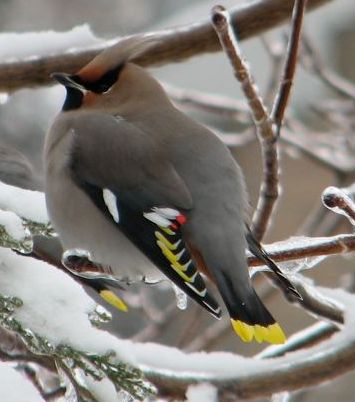
To the enjoyment of everyone, in early December, hundreds of Bohemian Waxwings were found feeding on berries on Orillia. People were reporting flocks of up to 500.
These birds are common in the west, breeding in the Yukon and Alaska. People speculate about the reasons for their unpredictable winter wanderings.
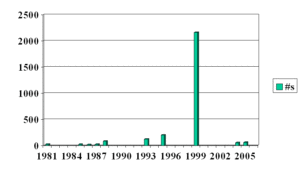 Some berries still remain in Orillia, but the birds did not, and so they were not around for the day of the Xmas bird count and so will not be on the chart to the left, unfortunately. Where have they gone? There are a few reports from Uxbridge and Norfolk County, but not large numbers. Muskoka, Barrie and Carden CBcounts all had small numbers of
Some berries still remain in Orillia, but the birds did not, and so they were not around for the day of the Xmas bird count and so will not be on the chart to the left, unfortunately. Where have they gone? There are a few reports from Uxbridge and Norfolk County, but not large numbers. Muskoka, Barrie and Carden CBcounts all had small numbers of
Bohemian waxwings.
These photos were taken by Doug Scott, On December 4, in the front yard of his home on Frontier Avenue. They were eating juniper berries and the front porch decorations of high bush cranberries. The photo on the left was taken by Joan Rosebush on Couchiching Point.
The chart on the left shows the reports of Bohemian Waxwings on Xmas Bird Counts in Orillia since 1981, demonstrating their irruptive behaviour. No Bohemian Waxwings were seen in Orillia on Dec 15/07.
FOR NOVEMBER 2007 Bird’s Nest Fungi
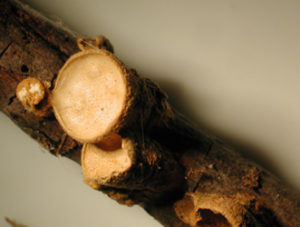
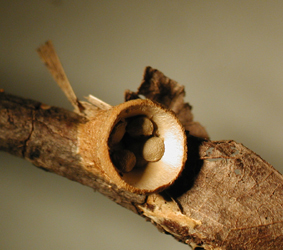
Janet Grand found these Bird’s Nest Fungi, or Crucibulum laeve, near the Black River, near Fairgrounds Road.. They are not rare, but are often overlooked since the tiny vase may be only about one cm high. There may be dozens, or even hundreds growing on rotten wood, or other decomposing materials.
On the left the operculum, or lid, which covers the top of the nest, is still intact. On the right, it has ruptured to reveal the little eggs, or peridioles, which contain the spores. A single rain drop can then splash the eggs out of the nest, the outer wall of the egg is eaten away by insects, and the spores are ready to reproduce.
FOR OCTOBER 2007 American Millipedes
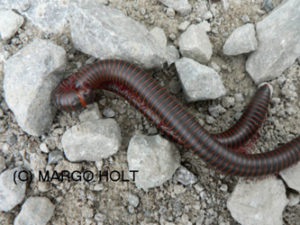
In September, while walking on a very degraded Hummer trail near the Big Chute, we saw, and watched these millipedes mating.
Narceus americanus, the American Millipede, or Pink Millipede, or Eastern Red-ribbed Millipede is the most common millipede in eastern North America. At 4 inches in length it is also the largest in our region. Millipede courtship involves the male walking along the female’s back & stimulating her with the rhythmic pulses of his legs, (quite the massage).
Although this is a common millipede is often seen among the leaves on the forest floor, it is unusual to see it mating in the open, in the daytime.
Millipedes , which have 2 pairs of legs per segment, can be easily distinguished from the somewhat similar and closely related centipedes which move rapidly, and have a single pair of legs for each body segment.
FOR SEPTEMBER 2007 Monarchs in Migration
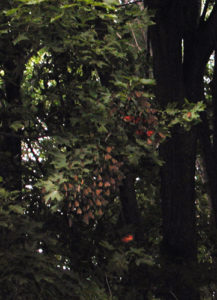 Monarch migration
Monarch migration
Everyone is talking about the Monarch sitings this summer. Trees laden with 1- 200 Monarchs clinging to several different branches in clusters, have been reported from Holcroft Road, in Orillia (photo on the left), and Matchedash Bay area – many more are probably unreported.
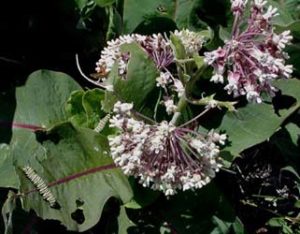
Many milkweed plants had been covered with caterpillars in July (there are 3 caterpillars showing in the lower photo -and many more are hidden).
In Ontario, migration of Monarchs are monitored at Long Point, Point Pelee and Prince Edward Point, all sites that are known to concentrate large numbers in the fall. Volunteers at Long Point Bird Observatory conduct a one-hour daily census between the beginning of August to early November,
and their results are shown on the right.
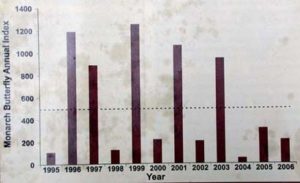
The last 3 years have been below average (broken line).
The results of 2007 and not in yet, but it probably will be a record year.
So, what does this mean? Speculation is rampant, but it is all speculation at present. Interesting, nevertheless.
FOR AUGUST 2007 Hine’s Emerald Dragonfly
Photo gallery below – use arrow on right to see more photos
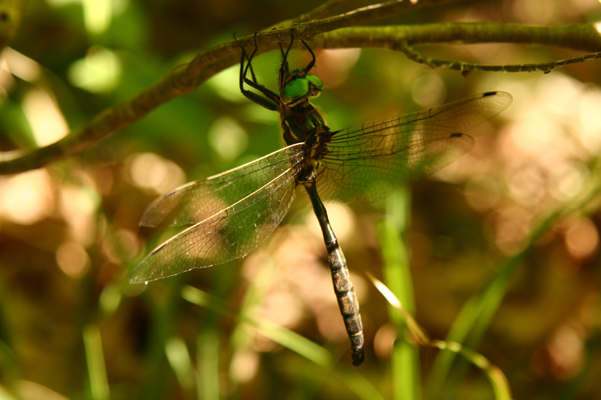
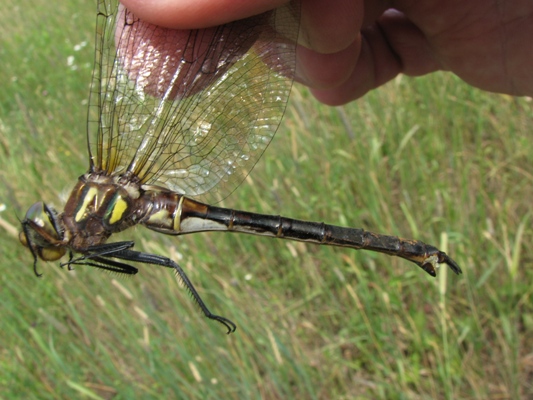
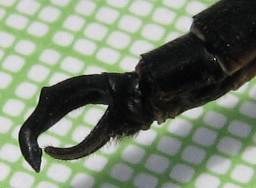
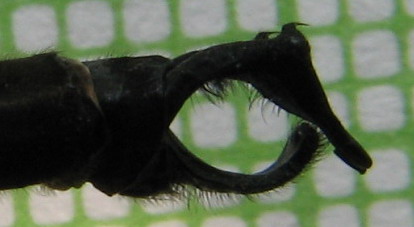
Chris Evans, although not a member of our club, is known to some of us because he has been on some outings with us. As you can see, he was EXCITED by his find (of the Month) The dragonfly – Hine’s Emerald.
“Just when you are having self doubts and beginning to think all of those funny looks you get when you are out catching dragonflies might be
justified, something incredible happens. You catch the first recorded specimen of Hine’s Emerald, Somatochlora hineana, in Canada. Of course,
you’re too inexperienced to know that, and with your novice zeal, miss-identify it as a Clamp-tipped Emerald, Somatochlora tenebrosa. None of
your references have Hine’s Emerald. After all, it is unknown in Canada and while Clamp-tipped Emerald isn’t a perfect match, it is still an uncommon
and exciting find and “close is good enough. There must be some individual variation, right?”
Unfortunately, he doesn’t survive the capture and hoping to donate his remains to science, you submit your record with photos and offer him to
Colin Jones at the Natural Heritage Information Centre (NHIC). Jaws hit the floor and emails fly back and forth, phone tag ensues and finally you get
the news that your specimen is “not S. tenebrosa but something far more exciting, Hine’s Emerald, Somatochlora hineana!” “Could you spell that? How is this so exciting?”, you ask. “Hine’s Emerald is the only dragonfly officially listed in the USA as federally endangered and has never been
recorded in Canada … until now!” “I killed the first record of Hine’s Emerald in Canada, a critically endangered species! Aaaarg!” Yep, that is more exciting than S. tenebrosa!
Start questioning the value and sanity of your pursuits and you may be rewarded beyond your wildest expectations. (I haven’t heard from the Nobel Foundation yet, but I’ll keep you posted.) “
There is more to the story – a colony was found, but this involved Chris getting lost in the Minesing Swamp etc -too long a story.
Dragonfly people carry long nets, chase fast flyers with vigour, and look at the appendages with a hand lens. Some are easy to identify on the wing. All are beautiful, and can be appreciated whether you can name them or not.
The quoted story and the photos are thanks to Chris Evans.
Hine’s Emerald – male
Hine’s Emerald -female, with ova
Hine’s Emerald – male ( appendages)
Clamp-tipped Emerald – male ( appendages)
FOR JULY 2007
Photo gallery below – use arrow on right to see more photos

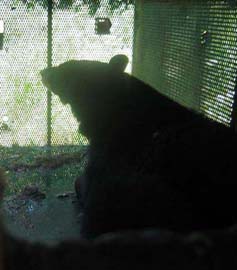
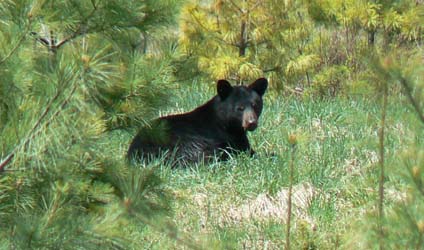
“A BEAR IN MY BACK PORCH”
The left hand photo shows the bear trap placed by the MNR. The Danger Bear Trap sign obscures the Welcome sign at Colleen’s front door.
The centre photo is Chucky, a young male about 18 months old, weighing 118 lb.
The photo on the right is the large male bear that was trapped June 24, 2007. The MNR took him to Swift Rapids to release him but they said he would return to this, his area.
Colleen Cooney lives at Lovering, In the Matchedash District of Severn Township. She tells us that “Chucky visited our area during the day, mornings and afternoons. He broke into my porch through the screens about 11 am. There was nothing in the porch to attract him. The MNR set a trap at my front door and when he was trapped they tranquillized him, weighed and measured him and took a sample of his hair. They released him at my front door and shot rubber pellets at him to scare him, a practice which is successful out West, to condition bears to be afraid of humans. But Chucky returned the next morning. So the trap was set again. This time the large male bear was caught at 3:15 a.m., but he had not been a nuisance.
One interesting thing I learned from the MNR is that the bears in the Owen Sound area are different genetically from the rest of the bears in the province.”
FOR JUNE 2007 Power of a burst beaver dam
Photo gallery below – use arrow on right to see more photos
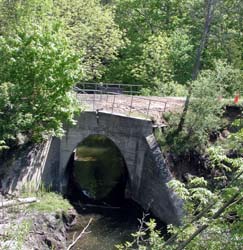
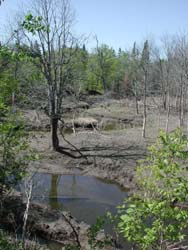
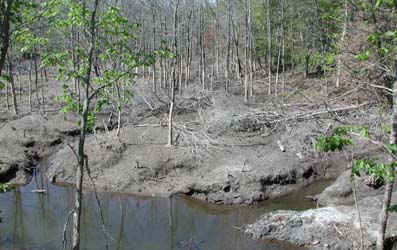
Many were aware, and interested, that a lake was building up, this spring, with ducks and other water birds. However we did not think of the problems being caused by the blockage of Silver Creek by the beaver. Only a small trickle remained. At the beginning of June, the Township realized that the dam had to be removed, and a digger was brought in. As soon as the bucket touched the dam, the dam gave, almost sucking in the bucket. The reinforced cement bridge on the Uhthoff Trail downstream from the plugged culvert was broken, and the trail seriously undermined by the force of the water. It appeared that the rush of water had carried debris 6 feet high downstream.
The flooded trees and plants were dead, as demonstrated in the two centre photos. The photo on the right, taken June 22/07, shows some regrowth, especially along the stream bed, but there is also a hint of green on the flood plane .Access to the ground in this area is difficult, but it will be interesting to see regeneration from the buried seed bank. We are especially looking for Northern St Johnswort (Hypericum mutilum spp boreale) which is a specialty of regenerating beaver ponds, and its yellow flowers will be beautiful to see, if it grows here.
This area can be seen from the old CNR railway line, and there is a small path to it from the Uhthoff Trail, north of Division Road, where the bridge is broken.
FOR MAY 2007 Blanding’s Turtle
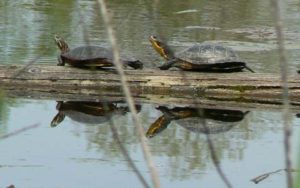
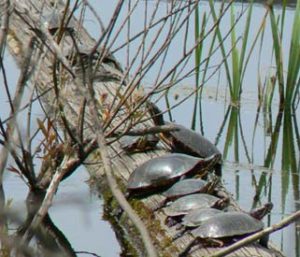
This Blanding’s Turtle was photographed in a line up of Painted Turtles, basking on a log in a beaver pond near the Swift Road ( Crown Land in Severn Township). It can be recognized by the outstretched yellow neck. Although the Blanding’s Turtle is widespread and fairly numerous, the population is declining.
In 2005 COSEWIC (Committee on the Staus of Endangered Wildlife in Canada) designated it as Threatened . Subpopulations are increasingly fragmented by the extensive road network that crisscrosses all of this turtle’s habitat. Having delayed age at maturity, low reproductive output and extreme longevity, this turtle is highly vulnerable to increased rates of mortality of adults. Nesting females are especially susceptible to roadkill because they often attempt to nest on gravel roads or on shoulders of paved roads. Another threat is degradation of habitat from development and alteration of wetlands.
About 60 Orillians learned of the efforts of Jeff Hutchings ( Wendy and Al’s son), who is Chairman of the COSEWIC , when he spoke to us about his efforts ( and frustrations) at a meeting at the Sundial this month. It makes us realize what a treasure we have in the wetlands in ” The Land Between” .
Photos by Donald MacDonald
FOR APRIL 2007 Sharp-tailed Grouse on Lek
Photo gallery below – use arrow on right to see more photos
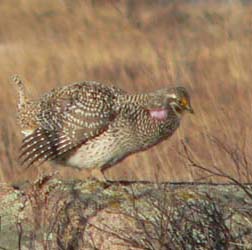
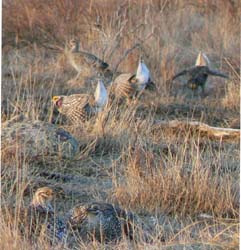
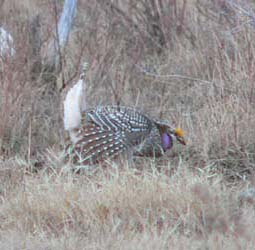
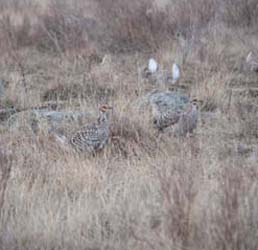
At dawn 19 members of the ONC visited the Sharp-tailed Grouse Lek (dancing ground) near the airport in Manitoulin Island, to see the mating dance. About 100 birds engage, with apparent seriousness, in some of the most unintelligible maneuvers ever performed in the natural world, almost like an ad for Eveready batteries( but apparently very important biologically). Only the male dances, while the females may occasionally be seen checking them out from the fringes of the dancing ground. The show lasts for about 2 hours. Sharptails once occupied northern Quebec, Ontario, and all the western provinces, as well the northern prairie and great plains of the USA. There are still heavy populations in the west, but the lek in Manitoulin is the most accessible for us. Photos by Helenmarie Darker and Donald MacDonald.
FOR MARCH 2007 Grub – Beetle larva

The large white grub is 3 cm. long & was found in a crack of a damaged tree trunk in Matchedash District, apparently dead and frozen, awaiting its awakening in the spring. It is a member of the Scarab beetle family (Scarabaeidae) & belongs to the genus Osmoderma of which there are 2 species in our area. These beetle larvae inhabit the rotting wood of large trees & are termed “saproxylic” meaning they are dependant on dead or dying wood. Lucky would be the Pileated Woodpecker or Red Squirrel that would find this tasty morsel, but unfortunate for the grub!
Identification and Photo by Margo Holt
Information, such as this, can be found in a great, new, beautifully illustrated book ” Insects – Their Natural History and Diversity”, by Stephen Marshall, a professor at the University of Guelph.
FOR FEBRUARY 2007 Fisher
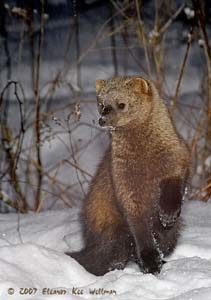
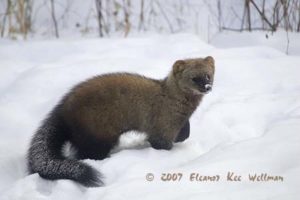
Fishers are large members of the weasel family- about the size of a medium sized dog, with short legs. While their favorite prey seems to be Snowshoe Hare, they are famous for their ability to kill and eat porcupines (by going at their face). When fishers are absent porcupines climb to large numbers.
By the 30’s and 40’s trapping had almost wiped out fisher. Today the martens and fisher are very common in much of forested southern Ontario. This change is attributed to Ontario’s system of registered trap lines. The trapper has exclusive access to an area, and therefore it is in his interest to leave some animals to produce future crops. “My “ trapper, in Matchedash District of Severn Township, had his quota of 5 early in the season, but many footprints can still be seen in the area.
DNA studies done at Trent University show that our Ontario fishers originated from animals that dispersed from the Adirondacks in New York State, and another eastern group is of Quebec origin. There were 3 remnant populations that made it through the long years of over-trapping: one in the southern Georgian Bay area, one near Bancroft, and one in the Algonquin Park refuge.
Excerpted and plagiarized from the Raven, August 2006, the visitors’ newsletter of Algonquin Park.
These remarkable photos were taken by Eleanor Kee Wellman, using a bait station outside her window in Muskoka
FOR JANUARY 2007
THE GARDEN IN THE CANOPY
Photo gallery below – use arrow on right to see more photos
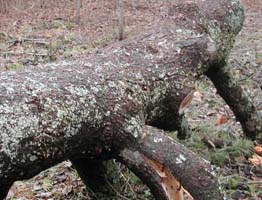

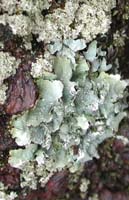
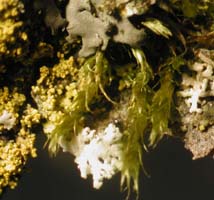
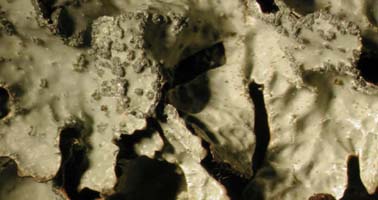
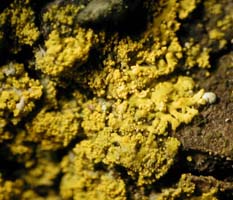
In October/06 the Couchiching Conservancy decided to cut the “Grandfather Tree” at Grant’s Woods . They feared for visitors when the dead pine fell. 3 Days before the tree was to be cut, it fell on its own, exactly where they wanted it to fall -a majestic end to 250 years.
This gave an unusual opportunity to make collections of the lichens and mosses on the bark at the 60 foot height. ( This is the height of the canopy walk in Haliburton). 7 species of mosses were identified, 3 of them new to the Grant’s Woods list ( they may be there but had not previously been identified ), numerous lichens which are still being studied, and a wealth of Rotifers and other small insects. A lot depended on that tree, but other trees will take its place, and many of these Bryophytes will continue to live on, on the forest floor.
